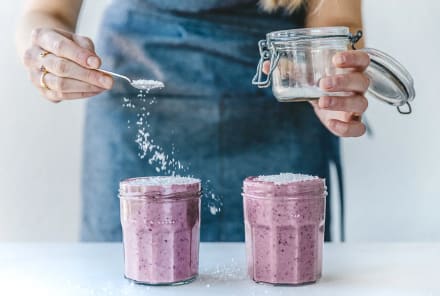Advertisement
If You're Not Eating This Food, You're Going To Have A Hard Time Getting In Shape


There are five main factors that determine performance. Everyone knows the first factor, and that’s training. Whether we are hitting the gym to build muscle or running to improve our cardio, the first step is always going to be lacing up your sneakers and getting active.
The other four factors are less obvious. Those four factors determine how well you perform during a workout, marathon, or an athletic competition. They are:
- Staying hydrated
- Keeping heart rate down
- Staying cool
- Maintaining blood circulation
What you may not know is that salt helps with each of those four factors—so much so that I’m proposing we consider it the sixth factor for achieving peak performance. Consuming more salt can even help to prevent overtraining1, which may actually be caused by our tissues becoming depleted in salt. Consuming more salt improves those four factors by increasing water retention and vasodilating the arteries. When these two effects are combined, you are more hydrated, circulation and blood flow to muscles improves, sweat production increases (helping to keep you cool), and heart rate goes down.
How does salt help with hydration? you might wonder. Most tap or bottled water contains zero sodium, and this increases the risk of hyponatremia, or low sodium levels in the blood. Hyponatremia is a very common problem, especially among endurance athletes, and it can be fatal. We don’t just sweat out water; we sweat salt. We need to consume salt with our water if we want to reduce the risk of dehydration, cramps, and hyponatremia. Indeed, one study2 concluded that the primary cause of muscle cramps during exercise in warm weather was sodium deficit.
This makes biological sense. When your body works hard, you sweat. And when you sweat, you sweat out salt. Failing to replace the salt that is lost drains your tissues of salt, with wide-ranging negative effects on your ability to keep going. For example, salt depletion can lead to muscle cramping, dizziness, and fatigue, the exact opposite effects that you want during competition.
But wait—what about blood pressure? All of our health agencies, government bodies, and dietary guidelines tell us to consume no more than 2,300 mg of sodium (or 1 teaspoon of salt) per day. The American Heart Association goes as far as telling Americans to consume less than 1,500 mg of sodium per day3. Never mind that the average person loses around 1,200 mg of sodium per hour of exercise, with some individuals losing more than 2,000 mg of sodium per hour4. And based on the above sodium losses, even if you are eating a normal sodium diet, if you are an avid exerciser you can still be at risk of salt deficit. It’s not hard to calculate how following the low-salt advice while exercising could lead to more harm than good, so you might want to think twice about holding the salt.
I’m often asked about whether consuming sports drinks gives us all the salt we need while we are exercising. The answer is a resounding no. Most sports drinks contain only around 300 mg of sodium per liter of fluid, four times less than the saltiness of our sweat (or around 1,200 mg of sodium per liter of sweat). The reason sports drinks are missing an extra 900 mg of sodium or so is because no one wants to drink something that tastes like sweat. It’s literally too salty, so the manufacturers of sports drinks simply leave that extra sodium out.
Closing that sodium gap is where you may find your competitive advantage. And dosing yourself with salt prior to and during exercise may be the best way to close that gap. The average person may lose about a half of a teaspoon of salt per hour of exercise in sweat. If the loss of salt through sweat is not replaced this may lead to symptoms such as exercise intolerance, muscle spasms and cramps, fatigue, elevated heart rate, dizziness, hypotension, heat stroke and even circulatory collapse. The average person may also lose about 50 mcg of iodine per hour of exercise in sweat (which is why I recommend Redmond Real Salt, which contains almost this exact amount of iodine per half teaspoonful of salt). Preventing the depletion of salt and iodine that occurs through sweating is a great strategy to help reduce the risk of overtraining syndrome and even potentially hypothyroidism. You can drink the salt, or simply put it on the food you eat before or after working out. While I lay out a more precise salt dosing regimen based on ambient temperature in my book, The Salt Fix, this is a good place to start.
Watch Next
Enjoy some of our favorite clips from classes
Enjoy some of our favorite clips from classes
What Is Meditation?
Mindfulness/Spirituality | Light Watkins
Box Breathing
Mindfulness/Spirituality | Gwen Dittmar
What Breathwork Can Address
Mindfulness/Spirituality | Gwen Dittmar
The 8 Limbs of Yoga - What is Asana?
Yoga | Caley Alyssa
Two Standing Postures to Open Up Tight Hips
Yoga | Caley Alyssa
How Plants Can Optimize Athletic Performance
Nutrition | Rich Roll
What to Eat Before a Workout
Nutrition | Rich Roll
How Ayurveda Helps Us Navigate Modern Life
Nutrition | Sahara Rose
Messages About Love & Relationships
Love & Relationships | Esther Perel
Love Languages
Love & Relationships | Esther Perel
What Is Meditation?
Box Breathing
What Breathwork Can Address
The 8 Limbs of Yoga - What is Asana?
Two Standing Postures to Open Up Tight Hips
How Plants Can Optimize Athletic Performance
What to Eat Before a Workout
How Ayurveda Helps Us Navigate Modern Life
Messages About Love & Relationships
Love Languages
Advertisement

Green Tea vs Black Tea: Caffeine, Health Benefits & When To Sip Each
Jillian Kubala, M.S., R.D.










